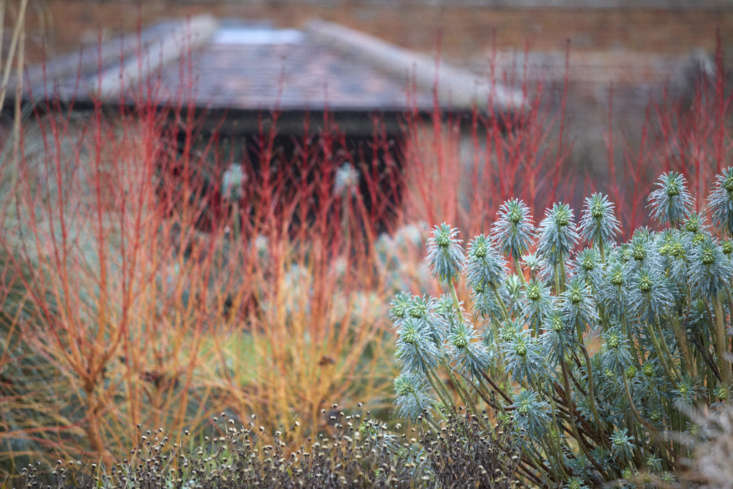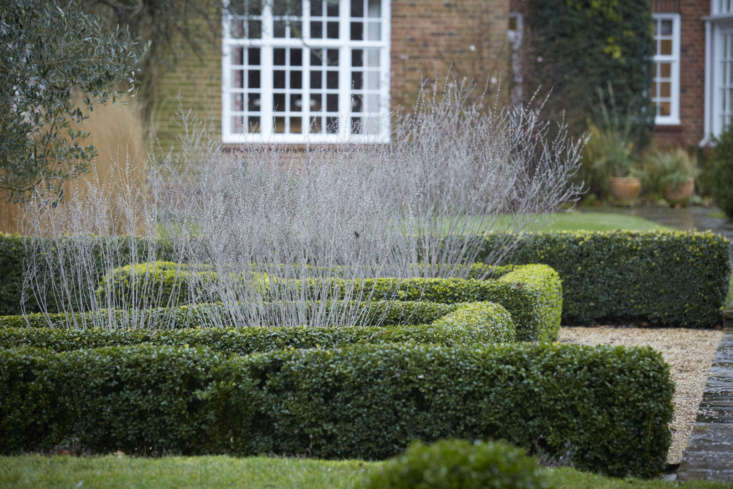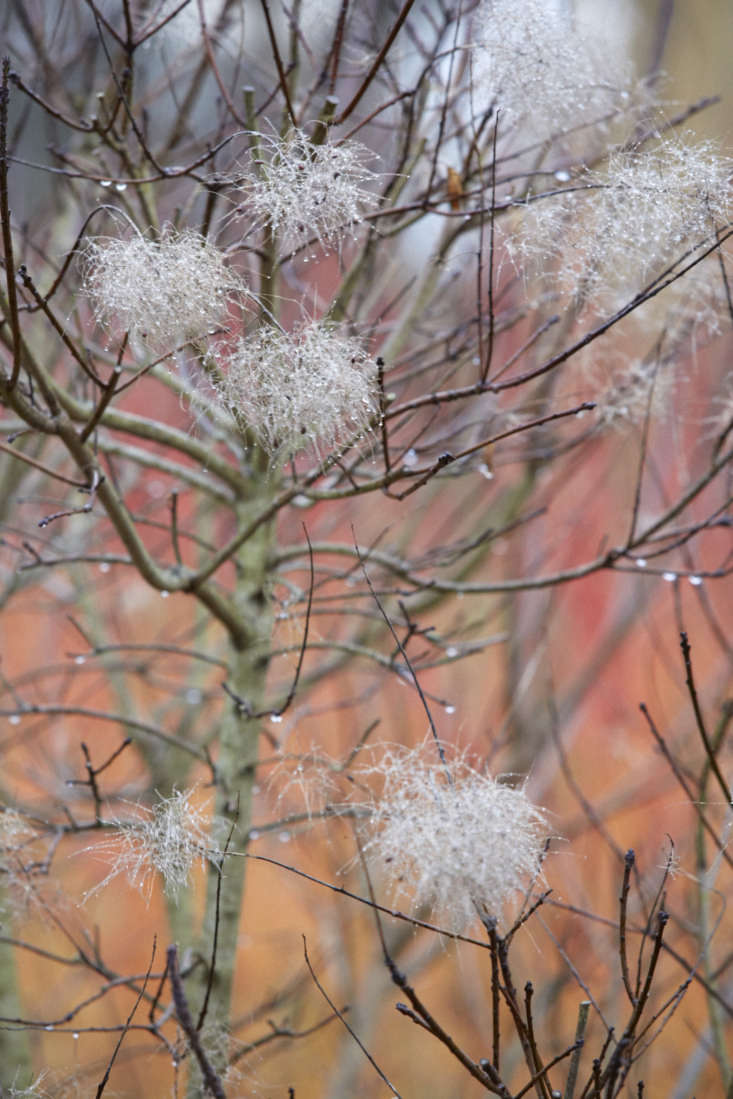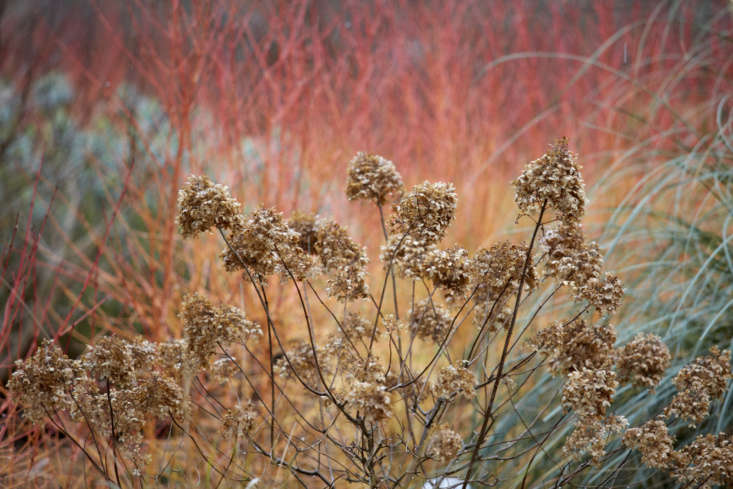When Sarah Pajwani and her family moved into their house near Maidenhead (an hour from London) in 2011, it was surrounded by an “overgrown field.” Having created a design rationale with the help of professional landscapers, Sarah set about filling her garden with plants of her choice, border by border. Despite her best efforts, in winter she would gaze out of the windows and still feel that there was nothing to look at.
Now, every garden-facing room in the house frames a different aspect of the winter scene, and the house has a lot of windows. Dare we suggest that winter is the garden’s best season? We can report that Saint Timothee, as it is called, was the first garden of the year to be open for the National Garden Scheme and Sarah gave us a tour.
Read on for 11 clever design ideas from Sarah to make the garden glow in the winter:
Photography by Britt Willoughby Dyer, for Gardenista.
1. Red Twig Dogwood

Saint Timothee is a picture of 1930s gentility, with an Enid Blyton kind of name. Yet the garden is not in a time warp. Sarah uses colorful stems, scented shrubs (such as Lonicera fragrantissima, Viburnum x bodnantese ‘Dawn’, Sarcococca confusa), sparsely flowering trees (Prunus x subhirtella ‘Autumnalis’) as well as grasses mixed with evergreens to brighten the winter scene. Several paths and borders lead the eye from one of the inside windows, across the garden.
2. Mixed Grasses

The view from the front hall, in close-up. Sarah is a huge fan of grasses, for their texture—and contrast with evergreens. They are also good winter performers, battling on in wind and rain, although they may need to be cut back early after heavy snow. Carex oshimensis ‘Evergold’ (in the foreground, Above) is used “to anchor corners and line paths,” explains Sarah. Other favorites are ever-reliable Stipa gigantea for height and grace, and Pennesetum macrourum, a medium-sized fountain grass, which keeps going even in prolonged periods of snow.
3. Pampas Grass

4. Feather Reed Grass

What motivated Sarah to grow Calamagrostis ‘Karl Foerster’ as a grass hedge? “Deciding what to plant here took me ages,” she explains. “I wanted something that would be easy to manage and give a moment of calm and simplicity, leading away from a busy, mixed border.
“The soil here is terrible; waterlogged, thick clay in winter which cracks in summer. In the middle is a big old apple tree, so it’s partly sunny and partly shady. Grasses had all done so well for us and I find them very easy.” Karl Foerster grows to about 4 feet.
5. Giant Boxwood


Evergreens are used judiciously throughout the garden. They are pruned, whether forming dwarf hedges or giant inverted cones of yew, further away from the house.
6. Purple Haze of Russian Sage


Also like the tall Calamagrostis, Perovskia keeps its shape until the moment it is razed to the ground, at the end of February.

7. Holly Hedge

Sarah and her family spend a lot of their time in the kitchen, which is built like a conservatory. “It is entirely open to the garden so the view is impossible to ignore,” explains Sarah. “We breakfast here and see the sunrise in the east, lighting up the skeletal silhouettes of deciduous trees to the Nnorth. Over the years we have made more of this end of the garden by planting an evergreen holly hedge at the garden boundary.”

“Holly is a native often found in English woodlands,” says Sarah. “It’s shade and drought tolerant—and I like it.”
8. Heavenly Hellebores

The divided leaves of Helleborus foetidus are more refined than those of most hellebores, including the other green-flowered variety, H. argutifolius. Sarah grows both but finds that stinking hellebore does better on drier soil, whereas her Corsican hellebore thrives in damper spots.
9. Contrasting Cornus

Sarah relies on three types of colorful dogwood stems to illuminate the garden in winter (they merge into the background in summer). These include two red-stemmed varieties not pictured here: Cornus alba ‘Sibirica’, which Sarah underplants with white cyclamen, and Cornus alba ‘Elegantissima’, underplanted with white periwinkle.
10. Smokebush Seed Heads

11. Hydrangeas

“Hydrangea ‘Limelight’ seed heads look good all through winter, and are important as protection from frosts,” says Sarah. She grows hers against a backdrop of strong color, whether that is a contrast of evergreen or a complement of fiery red.
See more surprisingly colorful winter gardens (and read about how to design your own:
- Curb Appeal: 11 Ways to Make Your House Look Welcoming in Winter
- Before & After: From a Blank Canvas to a Golden Garden in a London Suburb
- Expert Advice: 9 Tips for a Colorful Winter Garden
- Grasses 101: A Field Guide to Planting, Care & Design
- The Beauty of Decay: 10 Perennials to Add Structure to a Winter Garden








Have a Question or Comment About This Post?
Join the conversation